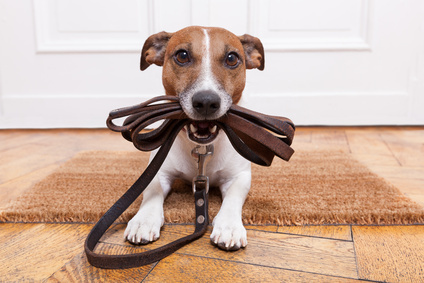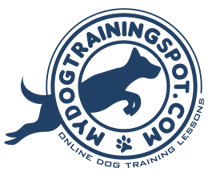How to Choose A Comfortable Walking Leash
I can still remember being at the pet store 15 years ago while choosing a leash for my new puppy. I knew exact what type of leash I wanted. A blue one. That was the only important attribute that was relevant to me then. I can’t remember anything else about that leash other than that. It was that puppy I was buying the leash for that would lead to my future occupation as a professional dog trainer.
 As of today, I know exactly what type of leash I want for which situation. I have held hundreds maybe even a thousand different leashes in my hands to date.
As of today, I know exactly what type of leash I want for which situation. I have held hundreds maybe even a thousand different leashes in my hands to date.
I find that many owners are like I was years ago and not really sure what type of leash would work best. If you go by popularity or what is generally most available online or at the big box stores, you probably have a 1 inch wide nylon leash. There are however, other choices that will provide a much more comfortable feel in your hand.
4 considerations for your next leash purchase
1. Width
The width of a leash directly correlates to the comfort level in your hand. I generally find that dog owners with big dogs choose leashes that are wider than necessary. In my experience, the majority of owners that have large or strong pulling dogs walk them with leashes that are 1 inch in width.
The width of the leash I prefer for most dogs has a width of 5/8 inch. If I am walking a dog under 30lbs, I may choose a leash that is ½ inch wide. Here are a few benefits that a 5/8inch or 1/2 inch wide leash will provide over the wider leashes.
- Moving down in width will make a big difference in how the leash feels in your hand. You can grip a leash in a lot of different ways, but they all involve fitting the leash inside your hand while making a fist. The thinner the leash, the more room you have, the more comfortable it will feel in your hand.
- A thinner leash provides more flexibility using different leash grips. I usually run a leash in between my fingers so the thinner leashes fit bitter.
- If you walk multiple dogs at the same time, it is more difficult to hold two wide leashes in one hand.
- A 5/8 inch wide leash that is in good condition will have no problem controlling a hundred pound plus dog.
2. Material
Material is probably the second most important consideration for comfort level. Nylon leashes seem to be the most available leashes for consumers. I find some of the nylon leashes very uncomfortable in my hand especially if they are an inch wide. The material can also create an edge that has the tendency to cut into the palm of the hand. I find cotton or leather leashes to be much more comfortable. Here are few benefits cotton or leather leashes provide:
- Leashes made of cotton or leather will be much softer on your hands.
- A leather leash will get softer the more you use it.
- A quality cotton leash or leather leash is not as stiff as most of the nylon leashes which allows the material to conform to your hand.
- Cotton leashes are inexpensive and easy to replace if you forget and leave it around a teething puppy.
- Leather leashes are more expensive so I do not recommend them if your dog has the tendency to chew on the leash.
3. Length
The majority of walking leashes come in lengths of 2ft, 4ft, 5ft, and 6ft. I always opt for the 6ft leash for most situations.
- A thin soft leash is easy to take up slack in your hand when you need to make it shorter, but you can never make a short leash longer.
- The only time I would choose a 2 or 4 ft. leash is when I am training a dog to run beside a bike so I don’t have to deal with dangling material.
- It is also easier to teach a dog not to pull with the longer leashes, because you can use freedom as a reward for walking next to you.
4. Connection Type
Leashes will come in two basic styles. They will either have a latch to hook on to a collar or will be designed in a slip lead fashion. I will use slip leads often to move dogs around from one point to another, but I prefer a latch system for walking or training.
- A latch leash can easily be made into a slip lead by running one end through the hand loop
- Slip leads can slide off if the dog puts slack in the leash
- Slip leads can also become infinitely tight which can lead to choking if your dog has the tendency to pull on the leash.
The leash that I use every day is 6 foot cotton web leash that is 5/8inch wide.
Leash Grip
Since we are on the subject of leashes, I thought I would take a quick moment and give you a tip on holding your leash. There a lot of ways to hold or grip a leash. You may have never thought that holding a leash in a different way would make a difference on how the leash feels in your hand.
I will usually grip the leash so that it “locks” in my hand. By using a locking grip, the leash cannot slide through my hand which is very useful when holding back a large dog that is trying to gain access to something that it sees on the other side of the street. I also find this type of grip much more comfortable in general.
The video below will show you one way to grip a leash so that it locks in your hand:
Published on July 23, 2017
2 Free Lessons!
Hi, I'm Tommy Grammer and I have helped thousands of dog owners just like you.
I teach people how to train their dogs and resolve behavior that is causing owners frustration. Sign up for my free tips and as a gift to show you how my methods work, I will send you 2 sample lessons from the members' area!

Unleash your dog's potential by learning how to train like a professional trainer.
Train Your Dog
The Gift of Training
A My Dog Training Spot 12 month membership makes a wonderful gift, any time of year. Give a dog owner you care about the gift of training!


